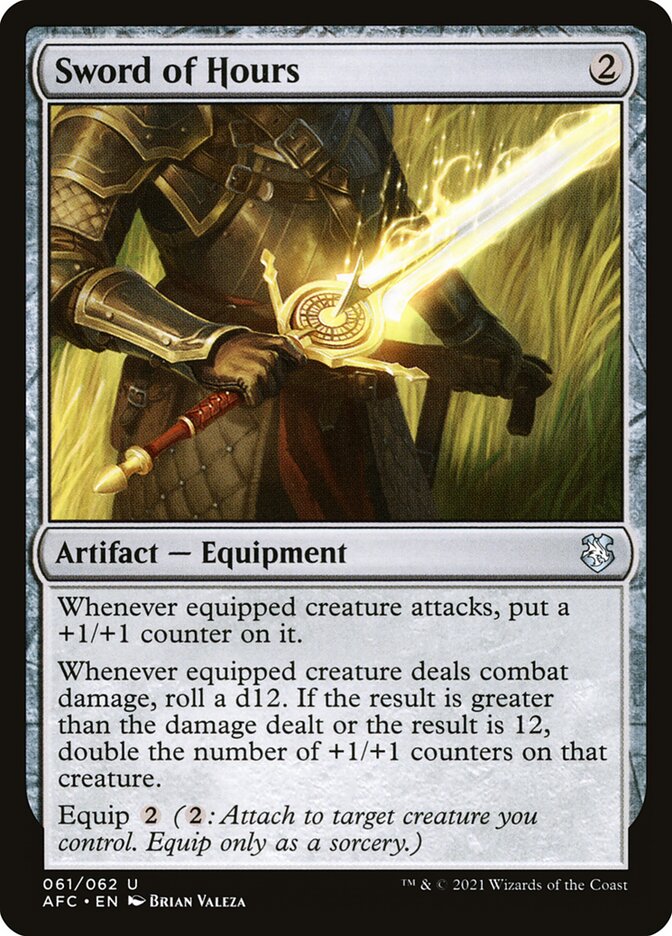
Sword of Hours {2}
Artifact — Equipment
Whenever equipped creature attacks, put a +1/+1 counter on it.
Whenever equipped creature deals combat damage, roll a d12. If the result is greater than the damage dealt or the result is 12, double the number of +1/+1 counters on that creature.
Equip {2} ({2}: Attach to target creature you control. Equip only as a sorcery.)
Illustrated by Brian Valeza
- Standard
- Not Legal
- Alchemy
- Not Legal
- Pioneer
- Not Legal
- Explorer
- Not Legal
- Modern
- Not Legal
- Historic
- Not Legal
- Legacy
- Legal
- Brawl
- Not Legal
- Vintage
- Legal
- Timeless
- Not Legal
- Commander
- Legal
- Pauper
- Not Legal
- Oathbreaker
- Legal
- Penny
- Not Legal
Toolbox
Buy This Card
Notes and Rules Information for Sword of Hours:
- To double the number of +1/+1 counters on a permanent, count the number of +1/+1 counters that are currently on that permanent and put that many more on it. Any replacement effects that change this number will apply accordingly. (2021-07-23)
- If the equipped creature takes lethal damage at the same time that it deals combat damage, it will die before the counters on it can be doubled. However, you will still roll a d12, which may cause abilities of other permanents to trigger. (2021-07-23)
- Dice are identified by the number of faces each one has. For example, a d20 is a twenty-sided die. (2021-07-23)
- Dice used must have equally likely outcomes and the roll must be fair. Although physical dice are recommended, digital substitutes are allowed, provided they have the same number of equally likely outcomes as specified in the original roll instruction. (2021-07-23)
- An ability that tells you to roll a die will also specify what to do with the result of that roll. Most often, this is in the form of a “results table” in the card text. (2021-07-23)
- The instruction to roll a die and the effect that occurs because of the result are all part of the same ability. Players do not get the chance to respond to the ability after knowing the result of the roll. (2021-07-23)
- An effect that says “choose a target, then roll a d20” or similar still uses the normal process of putting an ability on the stack and resolving it. Choosing targets is part of putting the ability on the stack and rolling the d20 happens later, as the ability resolves. (2021-07-23)
- Some effects may modify the result of a die roll. This may be part of the instruction to roll a die or it may come from other cards. Anything that references the “result” of a die roll is looking for the result after these modifications. Anything that is looking for the “natural result” is looking for the number shown on the face of the die before these modifications. (2021-07-23)
- Some abilities, like that of Pixie Guide and Barbarian Class, replace rolling a die with rolling extra dice and ignoring the lowest roll. The ignored rolls are not considered for the effect that instructed you to roll a die, and do not cause abilities to trigger. For all intents and purposes, once you determine which dice count, any extra dice were never rolled. (2021-07-23)
- Some effects instruct you to roll again. This uses the same number and type of dice as the original roll, and that roll will use the same set of possible outcomes. (2021-07-23)
- While playing Planechase, rolling the planar die will cause any ability that triggers whenever a player rolls one or more dice to trigger. However, any effect that refers to a numerical result will ignore the rolling of the planar die. (2021-07-23)
- Tournament events have more specific rules regarding dice and die-rolling. For more information, please see the most recent version of the Magic Tournament Rules at wpn.wizards.com/en/document/magic-g… (2021-07-23)